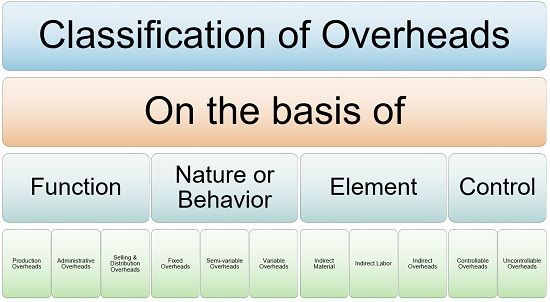Definition: Overheads can be understood as the indirect expenditure which can’t be appropriately charged to or economically identified with any specific cost centres, cost object or cost unit.
The overheads are not related to individual jobs, work order or products rather they are incurred in connection to the output, or in providing certain incidental facilities or services, for undertaking the operations.
Overheads are incurred in large amounts in production, administration, selling and distribution of goods and services, as they are incurred for the basic organization of the enterprise and so a specific proportion of total cost belongs to the overheads. It comprises of indirect materials, indirect employee/labour costs, indirect expenses.
Classification of Overheads
- Based on Function:
- Production Overheads: Otherwise called as factory or manufacturing overheads, these are the indirect costs spent on the production or rendering of services, right from the procurement of raw materials from suppliers to creation of the final product.It includes expenses such as repairs and maintenance of plant, depreciation of factory, primary packing expenses, etc.
- Administrative Overheads: These expenses are incurred in connection to the general management, accounting, and administration activities of the concern. Office and Administrative expenses do not relate to production, marketing, selling and distribution, research and development functions of the enterprise.It covers salary paid to employees, depreciation of building, postage and stationery, accounts and audit expenses.
- Selling and Distribution Overheads: Selling overheads refers to the indirect expenses incurred in the selling of products such as salesmen salary, commission, allowances, advertisement expenses, etc.On the other hand, distribution overheads include all those expenses which are spent by the firm in making the product or service available for sale in the marketplace.
Expenses like delivery truck expenses, driver’s salary, secondary packing expenses, warehouse and godown rent, etc. come under this category.
- Based on Nature or Behavior:
- Fixed Overheads: As the name suggests, fixed overheads, refers to the expenses which remain unchanged irrespective of the level of activity. They are incurred for a specific period and so they are not affected by the production activity.It includes depreciation on building and plant, salary paid to employees, office or factory rent, interest on capital, premium paid on insurance, etc. These expenses are same, year to year, except if a change is made voluntarily by the firm.
- Semi-Variable Overheads: The expenses which are partially fixed and partially variable comes under this category, as they combine the feature of both fixed and variable overheads. These do not increase or decrease in direct proportion to the output produced. These are electricity, telephone bill, internet usage, etc.
- Variable Overheads: Variable overheads have a direct relationship with the production level, as they increase with the increase in activity level, and vice versa. It increases or decreases in total with an increase or decrease in output, but its unit cost remains the same.Expenses relating to the use of power and fuel, lubricants, indirect materials and so forth, are covered here.
- Based on Element:
- Indirect Material: Material which is used while producing the product, but does not form part of the final product. So, they cannot be directly traceable to a particular product or job. For Example glue, oil, tape, disposable tools, cleaning material, lubricants, stationery, etc.
- Indirect Labor: Indirect labour or indirect employee cost includes the cost of labour which does not actively participate in the production process, but act as supporting staff. And so they are not directly involved in the conversion of goods. It includes the salary of production supervisor, guards, watchman, accountants, storekeeper, foremen etc.
- Indirect Expenses: Indirect expenses are those expenses which cannot be outrightly and completely chargeable to a particular cost centre or cost object. The examples of indirect expenses are factory rent, insurance, general repairs, welfare expenses, medical, recreation service, audit fees, patent expenses, customer service expenses, after-sales service expenses, etc.
- Based on Control:
- Controllable Overheads: The costs which are controllable in nature, i.e. these expenses can be regulated with proper implementation of policies and plans. These can be material cost, fuel, etc.
- Uncontrollable Overheads: The expenses, whose incurrence are not under the control of the management are termed as uncontrollable overheads. It includes taxes, interest on loan, depreciation, and so on.
One thing is to be noted that before the commencement of the period first of all the amount of overheads is estimated, and then the estimated amount is distributed over different cost units and that too, on an estimated basis.


Leave a Reply